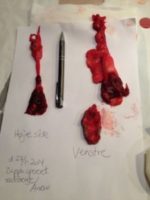GELDING SCARS
As a equine body worker I can see clinical symptoms of the condition called “gelding scars”. Geldings, in their teens that lost propulsion (from their hind leg), sensitive in their lumbar, lumbar/sacral, sacral region, sometimes with cow hock posture and changes in their feet/hooves conformation.
When their castration site is checked it feels usually cold, with palpable rubbery tissue in the ” scrotum”. Some of these bands are easily traced toward inguinal region. For some horses this can be already unpleasant.
As an anatomist I can see the “inside” of the castration scars – when the stump of the spermatic cord is adhered in the area of the inguinal canal, sometimes to the skin “of what ever is left from scrotum”.
I can imagine that with every step that the horse takes this connection is “pulling” and surely one can explain the broad spectrum of symptoms that these horses exhibit.
I found some nice pictures of the deep inguinal canal, as well as a short clip where one can see the connection between “inside” and the skin of the “scrotum” (watch and excuse the discussion around).
Ductus deferens – a tube that carries a sperms from the testis (testicle) to urethra
Spermatic cord – an aggregate structure consisting of ductus deferens and testicular vein and artery, with nerves and lymph vessels. This structure is severed during the castration surgery.
Inguinal canal – a potential space between external and internal abdominal oblique muscle through which the testes (with its vessels and of course spermatic cord ) pass from the abdominal cavity into the groin.
Testicles are developed inside the abdominal cavity and need to descend into a scrotum (via inguinal canal) to be able to produce healthy sperm cells (they need a lower temperature). This process takes place just before the birth or shortly after the birth. It it fails – and the testicle is in the abdomen or trapped in inguinal canal we speak about cryptorchidism.


